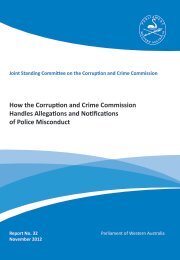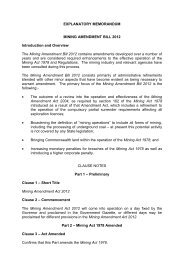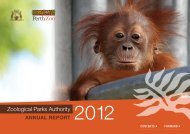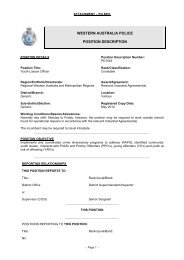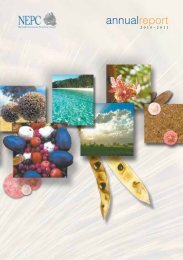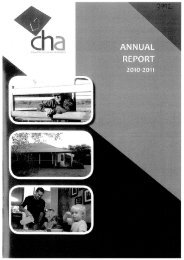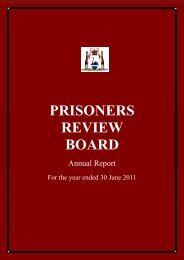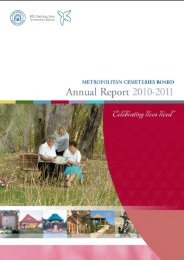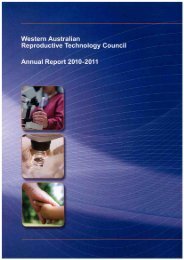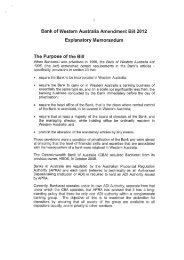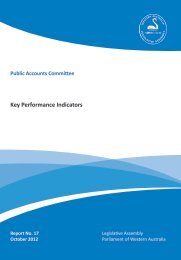Challenger TAFE | Annual Report 2006 - Parliament of Western ...
Challenger TAFE | Annual Report 2006 - Parliament of Western ...
Challenger TAFE | Annual Report 2006 - Parliament of Western ...
You also want an ePaper? Increase the reach of your titles
YUMPU automatically turns print PDFs into web optimized ePapers that Google loves.
<strong>Challenger</strong> <strong>TAFE</strong><br />
NOTES TO THE FINANCIAL STATEMENTS<br />
FOR THE YEAR ENDED 31 DECEMBER <strong>2006</strong><br />
<strong>Challenger</strong> <strong>TAFE</strong> | <strong>Annual</strong> <strong>Report</strong> <strong>2006</strong> 91<br />
Subsequent measurement<br />
After recognition as an asset, the revaluation model is used for the measurement <strong>of</strong> land and buildings and the cost model for all<br />
other property, plant and equipment. Land and buildings are carried at fair value less accumulated depreciation on buildings and<br />
accumulated impairment losses. All other items <strong>of</strong> property, vehicles, plant and equipment are stated at fair value with the exception<br />
<strong>of</strong> Works <strong>of</strong> Art which are shown at historical cost.<br />
Where market-based evidence is available, the fair value <strong>of</strong> land and buildings is determined on the basis <strong>of</strong> current market<br />
buying values determined by reference to recent market transactions. When buildings are revalued by reference to recent market<br />
transaction, the accumulated depreciation is eliminated against the gross carrying amount <strong>of</strong> the asset and the net amount restated<br />
to the revalued amount.<br />
Where market-based evidence is not available, the fair value <strong>of</strong> land and buildings is determined on the basis <strong>of</strong> existing use. This<br />
normally applies where buildings are specialised or where land use is restricted. Fair value for existing use assets is determined by<br />
reference to the cost <strong>of</strong> replacing the remaining future economic benefi ts embodied in the asset, ie. the depreciated replacement<br />
cost. Where the fair value <strong>of</strong> buildings is dependent on using the depreciated replacement cost, the gross carrying amount and the<br />
accumulated depreciation are restated proportionately.<br />
Independent valuation <strong>of</strong> land and buildings are performed independently on an annual basis by the Department <strong>of</strong> Land<br />
Information (Valuation Services). With suffi cient regularity to ensure that the carrying amount does not differ materially from the<br />
asset’s fair value at the balance sheet date.<br />
The most signifi cant assumptions in estimating fair value are made in assessing whether to apply the existing use basis to assets.<br />
Pr<strong>of</strong>essional judgement by the valuer is required where the evidence does not provide a clear distinction between market type assets<br />
and existing use assets.<br />
Refer to note 26 ‘Property, plant and equipment’ for further information on revaluations.<br />
Depreciation<br />
All non-current assets having a limited useful life are systematically depreciated over their estimated useful lives in a manner that<br />
refl ects the consumption <strong>of</strong> their future economic benefi ts.<br />
Land is not depreciated. Depreciation on other assets is calculated using the straight line method, using rates which are reviewed<br />
annually. Estimated useful lives for each class <strong>of</strong> depreciable asset are:<br />
Buildings 40 to 95 years<br />
Leasehold Improvements 4 to 13 years<br />
Motor Vehicles, Caravans and Trailers 5 to 23 years<br />
Plant, Furniture and General Equipment 4 to 28 years<br />
Computing, Communications and S<strong>of</strong>tware 1 to 15 years<br />
Marine Craft 8 to 19 years<br />
Works <strong>of</strong> art controlled by the College are classifi ed as plant, property and equipment which is anticipated to have a very long and<br />
indefi nite useful lives. Their service potential has not, in any material sense, been consumed during the reporting period and so no<br />
depreciation has been recognised.<br />
(h) Intangible Assets<br />
Capitalisation/Expensing <strong>of</strong> assets<br />
Acquisition <strong>of</strong> intangible assets costing over $5,000 and internally generated intangible assets costing over $50,000 are capitalised.<br />
The cost <strong>of</strong> utilising the assets is expensed (amortised) over their useful life. Costs incurred below these thresholds are immediately<br />
expensed directly to the Income Statement.<br />
All acquired and internally developed intangible assets are initially recognised at cost. For assets acquired at no cost or for nominal<br />
consideration, the cost is their fair value at the date <strong>of</strong> acquisition.<br />
The cost model is applied for subsequent measurement requiring the asset to be carried at cost less any accumulated amortisation<br />
and accumulated impairment losses



